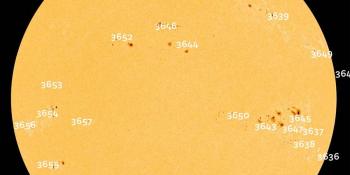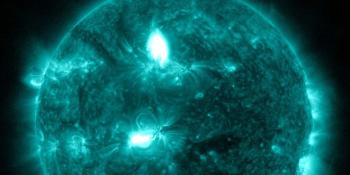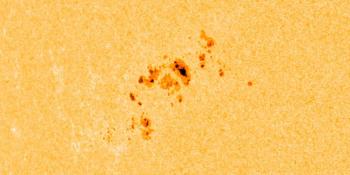Viendo archivo del miércoles, 19 noviembre 2003
Informe actividad solar
Any mentioned solar flare in this report has a scaling factor applied by the Space Weather Prediction Center (SWPC). Because of the SWPC scaling factor, solar flares are reported as 42% smaller than for the science quality data. The scaling factor has been removed from our archived solar flare data to reflect the true physical units.
Informe de actividad Solar-Geofísica 2003 Nov 19 2200 UTCPreparado por NOAA © SWPC y procesado por SpaceWeatherLive.com
Informe conjunto USAF/NOAA de actividad Solar y Geofísica
SDF Número 323 Publicado el 2200Z a las 19 Nov 2003IA. Análisis de regiones solares activas y de actividad desde 18-2100Z hasta 19-2100Z Solar activity has been moderate. Region 501 (N03W04)
continues to be active, generating a series of high C-class flares
and an M1.7 at 19/0401Z. Region 508 (S17E75) formerly old Region
486, was newly numbered today.
IB. Pronóstico de la actividad solar
Solar activity is expected to be
moderate. Regions 505 (S22E41) and 506 (S20E62), along with 501
will continue to be a strong threat for M-class flare activity.
IIA. Resumen de la actividad geofísica 18-2100Z a 19-2100Z
The geomagnetic field has been at quiet to active levels. The
coronal hole which had driven high solar wind speeds for the last
few days, has progressed beyond geoeffective range, and activity has
relaxed. The greater than 2 MeV electron flux at geosynchronous
orbit reached high levels today.
IIB. Pronóstico de la actividad geofísica
The geomagnetic field is
expected to be at quiet to minor storm levels for the next 24 hours.
Minor storm levels should occur near the middle of the period, due
to a glancing blow from an interplanetary shock issued by an M4
flare on 17 Nov. Beginning near midday on day 2, magnetic activity
should jump quickly to active to major storm levels for the
remainder of the period. A strong shock associated with a
combination of a disappearing solar filament and coronal mass
ejection should impact the Earth's magnetic field on or about 20 Nov
at 1200Z.
III. Probabilidades del evento 20 Nov a 22 Nov
| Clase M | 80% | 80% | 80% |
| Clase X | 20% | 25% | 25% |
| Protón | 15% | 20% | 20% |
| PCAF | yellow | ||
IV. Penticton 10.7cm flujo
Observado 19 Nov 155 Previsto 20 Nov-22 Nov 180/200/210 Media de 90 Días 19 Nov 128
V. Índices Geomagnéticos A
Observado Afr/Ap 18 Nov 018/020 Estimado Afr/Ap 19 Nov 015/020 Previsto Afr/Ap 20 Nov-22 Nov 040/050-030/040-015/015
VI. Probabilidades de Actividad Geomagnética 20 Nov a 22 Nov
| A. Latitudes Medias | |||
|---|---|---|---|
| Activo | 35% | 30% | 35% |
| Tormenta Menor | 35% | 25% | 15% |
| Tormenta Mayor-Severa | 20% | 15% | 10% |
| B. Latitudes Altas | |||
|---|---|---|---|
| Activo | 30% | 35% | 40% |
| Tormenta Menor | 30% | 35% | 20% |
| Tormenta Mayor-Severa | 25% | 20% | 15% |
< < Ir a la visión general diaria
Últimas noticias
Últimos mensajes del foro
AR 3637, 3638, 3643 87Unproven theories 341Space Weather Memes 338Filaments and prominences 55Growth of Cycle 25 433
Más temasApoye a SpaceWeatherLive.com!
Mucha gente viene a SpaceWeatherLive para seguir la actividad del Sol o previsión de aurora, pero con esta cantidad de tráfico se incrementan los costos del servidor. ¡Considere hacer una donación si disfruta de SpaceWeatherLive para que podamos mantener el sitio web en línea!

Hechos clima espacial
| Último evento clase X | 2024/03/28 | X1.1 |
| Último evento clase M | 2024/04/24 | M2.0 |
| Últimas tormentas geomagnéticas | 2024/04/19 | Kp7 (G3) |
| Días sin manchas | |
|---|---|
| Último día sin manchas | 2022/06/08 |
| Promedio de manchas solares mensuales | |
|---|---|
| marzo 2024 | 104.9 -19.8 |
| Last 30 days | 133.9 +26.6 |


